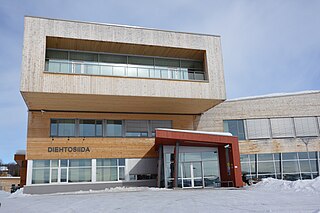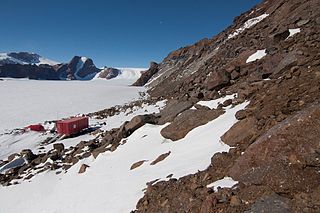
The University of Agder, formerly known as Agder College and Agder University College, is a public university with campuses in Kristiansand and Grimstad, Norway. The institution was established as a university college (høgskole) in 1994 through the merger of Agder College and five other colleges, including a technical college and a nursing school, and became one of Norway's new universities in 2007. It is among the youngest of Norway's ten universities.
As a feminine given name:
Norwegian School of Information Technology is a Norwegian information technology university college located in Oslo, Norway. It previously had schools located in Bergen, Stavanger and Bærum, but these were later shut down.
A university college in Denmark, Norway and Sweden is an independent institution that provides tertiary education and quaternary education (PhD). Most of these institutions traditionally had emphasis on less academic and more vocational programmes such as teacher or nursing education as well as shorter technical education; historically, these institutions were somewhat similar to a Fachhochschule in Germany and to a Polytechnic in the United Kingdom. The term is also used for some specialized universities.

Troll is a Norwegian research station located at Jutulsessen, 235 kilometers (146 mi) from the coast in the eastern part of Princess Martha Coast in Queen Maud Land, Antarctica. It is Norway's only all-year research station in Antarctica, and is supplemented by the summer-only station Tor. Troll is operated by the Norwegian Polar Institute and also features facilities for the Norwegian Meteorological Institute and the Norwegian Institute for Air Research.

Troll Airfield is an airstrip located 6.8 kilometres (4.2 mi) from the research station Troll in Princess Martha Coast in Queen Maud Land, Antarctica. Owned and operated by the Norwegian Polar Institute, it consists of a 3,300-by-100-metre runway on glacial blue ice on the Antarctic ice sheet. The airport is located at 1,232 metres (4,042 ft) above mean sea level and is 235 kilometres (146 mi) from the coast.

Sámi University of Applied Sciences is a university college that is located in the village of Kautokeino in Kautokeino Municipality in Finnmark county, Norway. It was established in 1989 and has about 150 students and 52 faculty, technical and administrative staff. It is one of 25 Norwegian state university colleges. Since 2009 it has been located at the campus complex of Diehtosiida.

Tor research station is a Norwegian Antarctic research station in Queen Maud Land.

Higher education in Norway is offered by a range of eight universities, nine specialised universities, 24 university colleges as well as a range of private university colleges. The national higher education system is in accordance with the Bologna process, with bachelor's degrees, master's degrees and doctoral degrees. Acceptance is offered after finishing upper secondary school with general university admissions certification.
Harstad University College was a høgskole, a Norwegian state institution of higher education, in the city of Harstad which is located in Harstad Municipality in Troms county, Norway. On 1 January 2016 it was merged with the University of Tromsø to become one of its several regional campuses.
Sogn og Fjordane University College is a høgskole, a Norwegian state institution of higher education, in the county of Sogn og Fjordane. The university college's campuses are located in Sogndal and Førde, and has approximately 3,800 students and 300 employees. The surrounding areas span over a variety of environments ranging from marine to high alpine, with glaciers and several nature parks on the World Heritage list.

The Norwegian Police University College is a public university college located in Oslo, Kongsvinger, Stavern and Bodø, Norway. It offers education for the police force of Norway, including a three-year basic education and a possible expansion with a Master's degree. 720 students are accepted at the Bachelor level each year. The university college also conducts research in relevant areas including law, police science, criminology, psychology and sociology. Unlike other public colleges, it is owned by the Norwegian Ministry of Justice and the Police.

SS Dronning Maud was a 1,489 ton steel-hulled steamship built in 1925 by the Norwegian shipyard Fredrikstad Mekaniske Verksted in Fredrikstad. Dronning Maud was ordered by the Trondheim-based company Det Nordenfjeldske Dampskipsselskap for the passenger and freight service Hurtigruten along the coast of Norway. She served this route as the company flagship until she was sunk under controversial circumstances during the 1940 Norwegian Campaign.
Norway's elongated shape, its numerous internal geographical barriers, and the often widely dispersed and separated nature of its settlement patterns are all factors that have strongly influenced the structure of the country's administrative subdivisions. It is a structure that has not only been subject to modification over time but one that remains subject to continuous review. As of late 2018, plans are nearing completion for a reform of the country's administrative divisions intended to lead, most notably, to the replacement of Norway's current 19 fylker (counties) by 11 new regioner (regions).

Queen Maud Land is a c. 2.7 million square kilometre (1.04 million sq mi) region of Antarctica claimed as a dependent territory by Norway. The territory lies between 20° west and 45° east, between the claimed British Antarctic Territory to the west and the similarly claimed Australian Antarctic Territory to the east. On most maps there had been an unclaimed area between Queen Maud Land's borders of 1939 and the South Pole until 12 June 2015 when Norway formally annexed that area. Positioned in East Antarctica, the territory comprises about one-fifth of the total area of Antarctica. The claim is named after the Norwegian queen Maud of Wales (1869–1938).

Norway has three dependent territories, all uninhabited and located in the Southern Hemisphere. Bouvetøya is a Subantarctic island in the South Atlantic Ocean. Queen Maud Land is a sector of Antarctica which spans between 20° west and 45° east. Peter I Island is a volcanic island located 450 kilometres (280 mi) off the coast of Ellsworth Land of continental Antarctica.
Four steamships have borne the name Dronning Maud, after the Norwegian Queen Maud:
Queen Maud fromage or Queen Maud is a dessert that predominantly consists of cream, kogel mogel and chocolate. Named after Queen Maud of Norway, daughter of King Edward VII. The Dessert was developed and introduced in Haugesund municipality, and presented to Queen Maud and King Haakon during their coronation expedition in 1906, and was eventually named in honour of their visit. The dessert is commonly consumed in the western region of Norway.










